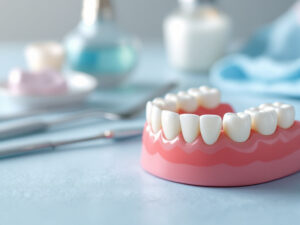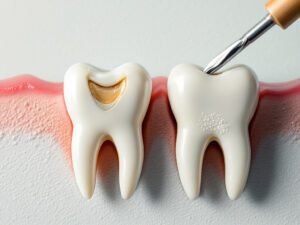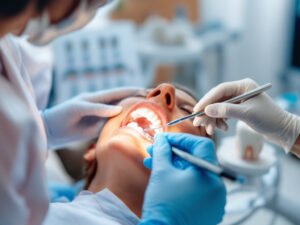Understanding tooth loss
If you’ve lost a tooth, you’re not alone—half of American adults aged 20 to 64 have lost at least one permanent tooth, and one in six over age 65 are missing all their teeth [1]. Whether due to decay, injury, gum disease or other factors, a missing tooth does more than affect your smile. When you choose to restore a missing tooth, it’s important to understand both the causes and the long-term consequences of leaving a gap untreated.
Causes of missing teeth
- Tooth decay and cavities that progress beyond repair
- Periodontal (gum) disease that damages supporting structures
- Trauma or accidents that fracture or dislodge teeth
- Congenital absence (having fewer teeth naturally)
- Failed dental work, like a broken bridge or crown [2]
Consequences of not replacing
Delaying tooth replacement can lead to a cascade of problems that impact your oral health, function and appearance.
Jawbone atrophy
When a tooth root is missing, the underlying bone loses stimulation and begins to resorb. Over time, you may experience jawbone loss at the extraction site, weakening the area and making future restorations more complex [3].
Tooth shifting and bite changes
Teeth adjacent to a gap tend to drift inward, altering your bite and potentially causing TMJ issues, headaches and difficulty chewing [3].
Gum disease risk
Misaligned teeth and tight spaces make cleaning harder, increasing plaque buildup and raising your risk of gingivitis and periodontal disease [3].
Facial and systemic effects
Without proper support, facial muscles can sag, leading to sunken cheeks, wrinkles around the mouth and an aged appearance [4]. You may also alter your diet to softer, less nutritious foods, affecting your overall health [4].
Understanding these risks underscores why it’s essential to explore reliable options to restore missing tooth function and aesthetics.
Exploring restoration options
Advances in restorative dentistry give you a variety of ways to replace or repair a missing tooth. Depending on the size of the gap, your oral health, budget and personal preferences, you can choose from:
- Minor repairs with fillings for small chips or cracks [5]
- Dental crowns to cap a damaged or root-canal treated tooth [6]
- Fixed bridges to span one or more adjacent gaps [7]
- Removable partial or full dentures [8]
- Dental implants for a permanent, natural-feeling solution [9]
Each method has its pros and cons. The sections that follow will help you compare durability, cost, procedure time and maintenance so you can make an informed choice.
Dental fillings for repair
If your missing tooth is small—perhaps a corner chipped off or minor enamel loss—a dental filling may be all you need to restore form and function.
When fillings apply
- Small chips or cracks on a single tooth
- Early decay that hasn’t reached the pulp
- Cosmetic repairs for minor surface flaws
Composite vs amalgam
- Composite (tooth-colored) fillings blend with your natural enamel and bond directly to the tooth structure. They require less removal of healthy tooth and offer a seamless look.
- Amalgam (metal) fillings are durable and cost-effective, but less esthetic.
Procedure overview
- Your dentist will isolate the tooth and remove any decayed or damaged tissue.
- The area is cleaned and etched (for composite) to promote adhesion.
- Filling material is placed incrementally, cured with a light (for composites) or packed (for amalgam).
- After shaping and polishing, you can bite and chew normally.
Fillings typically take under an hour and often are covered by dental insurance [10]. If decay has reached the pulp, your provider may recommend root canal therapy followed by a crown instead.
Crowns and bridges
When a tooth is too damaged for a simple filling but the root is healthy, a crown can cap the existing structure. If you’re missing one or more consecutive teeth, a bridge uses crowns on adjacent teeth to support a false tooth in the gap.
Types of crowns
- Porcelain-fused-to-metal crowns combine strength with a natural appearance [11].
- All-ceramic crowns offer superior esthetics for front teeth.
- Gold or metal crowns excel in durability for back teeth.
Bridge options
- Fixed bridge: crowns on two or more adjacent teeth support one or several pontics (false teeth).
- Resin-retained bridge: a minimally invasive option for front teeth that bonds a false tooth onto neighboring enamel with metal or ceramic wings.
Pros and cons table
| Option | Pros | Cons |
|---|---|---|
| Fixed crown & bridge | Stable, natural-feeling, full chewing function | Requires shaving healthy teeth |
| Resin-retained bridge | Less invasive, cost-effective | Less durable, limited to low-stress areas |
Treatment process
- Consultation and imaging: Your dentist evaluates your teeth, takes X-rays and discusses options.
- Tooth preparation: The teeth supporting the crown or bridge are reshaped.
- Impressions: Digital scans or molds ensure a precise fit.
- Temporary restoration: A temporary crown or bridge protects your teeth.
- Final placement: The permanent restoration is cemented in place during a second visit.
Recovering from crown and bridge work is quick. You may experience mild sensitivity, but you can typically return to normal eating in a day or two.
Dentures and implant-supported prosthetics
For multiple missing teeth or full arches, dentures and implant-supported options restore function affordably or permanently.
Removable dentures
- Partial dentures replace sections of missing teeth on a metal or acrylic base [12].
- Full dentures restore an entire arch but may slip without adhesives, require palate coverage (upper) or paste (lower) and can alter taste or trigger a gag reflex [13].
- Costs for full removable dentures average $1,968, ranging $1,520–$3,648 depending on materials [1].
Implant-supported overdentures
Attaching dentures to 2–4 implants offers better stability, comfort and chewing efficiency. You insert and remove them easily, while the implants maintain jawbone health. This option costs more than traditional dentures but is more affordable than full-arch implants.
Permanent hybrid bridges (All-on-4)
Also called “All-on-X,” these use 4–6 implants to support a full fixed arch. After extracting remaining teeth, implants are placed and a provisional prosthesis fitted. After 4–6 months of healing, you receive the final bridge. Benefits include:
- Fixed, natural feel and look
- Improved bone preservation
- High patient satisfaction
Costs average $15,176 per arch, ranging $11,640–$27,500 [1]. Surgical complexity and expense are higher, but many find the long-term benefits worthwhile.
Comparing treatment factors
Choosing the right way to restore missing tooth requires weighing multiple factors from cost to comfort.
Cost considerations
| Treatment | Avg. cost | Price range |
|---|---|---|
| Single implant | $2,695 | $1,450–$3,875 ([CareCredit]) |
| Three-unit bridge | $500–$1,500 (unit cost) | $1,500–$16,000 [14] |
| Full removable dentures | $1,968 | $1,520–$3,648 ([CareCredit]) |
| All-on-4 arch | $15,176 | $11,640–$27,500 ([CareCredit]) |
Durability and lifespan
- Fillings: 5–10 years
- Crowns/bridges: 10–15 years with proper care
- Dentures: 5–7 years before relining or replacement
- Implants: Over 95% success at 10+ years [15]
Recovery and maintenance
- Minor repairs: same-day, minimal sensitivity
- Crowns/bridges: 1–2 weeks total, avoid hard foods initially
- Dentures: adjustment period of weeks, adhesives often needed
- Implants: surgical healing 4–6 months, multiple visits
Aesthetics and comfort
- Fillings blend seamlessly in small repairs
- Crowns/bridges mimic natural teeth in shape and shade
- Dentures can look natural but may move without support
- Implants offer the most natural feel and preserve bone
Use this comparison to match your priorities—budget, longevity, comfort—and discuss with your provider.
Maintaining your restoration
Your new restoration deserves care to maximize its lifespan and protect overall oral health.
Daily oral hygiene
- Brush twice daily with a soft-bristle or electric toothbrush.
- Floss around crowns and bridges; use interdental brushes for implants.
- Consider a water flosser for All-on-4 or full-arch implants [15].
Professional cleanings
- Schedule cleanings and exams every six months.
- Implant restorations benefit from specialized tools to remove plaque and tartar [16].
Lifestyle considerations
- Avoid tobacco to support healing and prevent peri-implantitis [15].
- Limit hard, sticky foods on new crowns and bridges for the first two weeks.
- Use nightguards if you grind teeth to protect restorations.
Consistent care ensures your investment serves you for years to come.
Planning your restoration
A successful outcome starts with thorough planning and open communication.
Consulting your dentist
Begin with a comprehensive exam. Your dentist will:
- Review your medical and dental history
- Take X-rays or 3D scans to assess bone levels and anatomy
- Discuss options that match your oral health and lifestyle [17]
Insurance and financing
Check your dental plan for coverage levels on fillings, crowns, bridges or implants. Some insurers cover up to 50% of common restorative procedures [10]. For larger treatments, inquire about payment plans or third-party financing to spread costs.
Making informed decisions
- Ask about materials, techniques and expected lifespans.
- Request to see before-and-after photos of past patients.
- Verify your provider’s experience with the chosen procedure [18].
By partnering with a skilled dental team and weighing all factors—health, budget, appearance—you’ll restore missing tooth gaps confidently and enjoy lasting results.
Whether you need a quick composite repair or a full-arch implant solution, modern restorative dental procedures offer reliable ways to rebuild your smile, improve function and protect your oral health. Talk with your dentist today to find the best approach for your needs and reclaim your confidence in eating, speaking and smiling.
References
- (CareCredit)
- (repair broken dental work)
- (Michigan Implant Center)
- (The Implant Experts)
- (composite filling service, repair chipped tooth)
- (dental crown placement, porcelain crown restoration, root canal therapy)
- (dental bridge replacement, bridge & crown services, crown and bridge dentistry)
- (custom denture services, dental prosthetics services)
- (implant restoration dentist, dental restoration clinic)
- (insurance covered restorative dental)
- (porcelain crown restoration)
- (custom denture services)
- (Monfredi Family Dental)
- (Casas Adobes Dentistry)
- (Metrolina Periodontics & Dental Implants)
- (Barclay Family Dental)
- (dentistry for damaged teeth)
- (implant restoration dentist, bridge & crown services)










